Coyotes were sighted !!
Coyotes were sighted !!
The whole story started exactly like that. A friend of ours reported during our usual evening walk what she was told by her neighbor about apparently two coyotes been seen near a patch of woods nearby. As our dogs are not of anything near a coyote size, we were very hurt by a remark of another friend that a coyote could eeeeasily take out a small dog. Then the question was open, how big actually is a coyote. Opinions were offered, but it soon came out that the only person that has actually seen a coyote from a relatively short distance, was me. And in addition, I also took photos of the latest encounter, two years ago. Here they are, shot in the wonderful Joshua Tree National Park in southern California, short ride from San Diego. I love the place and the tree.
The distance to coyote was about 50 -70 yards, we were safely in the car, the animal was quiet and dignified. Not much in a hurry. Was relatively well fed. Wolfish. My previous encounter, some 15 years ago in southern Arizona, near Organ Pipe Cactus National Monument, was with a much skinnier coyote, may be less well nourished, or may be younger, so from then on, my view was that coyotes were much lighter. But that is not necessary true.
Coyote in Joshua Tree National Park, 2013
They can be easily confused with a young or hungry wolf. I think, wolf has a broader, Slavic (Polish) face, while coyote is skinnier, longer, more French or Celtic in its face, if you want to know how I see the difference. The immediate marker is the ears: rounded in wolf, and pointed and longer in coyote. So, from that point of view our Rufus qualifies more as a descendant of coyotes than wolves. For the proof, see below.
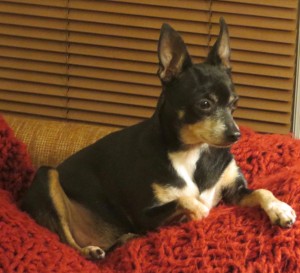 Rufus, The King of the Universe
Rufus, The King of the Universe
Coyotes live today practically everywhere (but only) in America, but apparently until the ‘80s they were rare at the east coast. Their natural environment is that of the West. Most commonly they are seen in central western states. All times I saw them, or heard their characteristic howling was in Arizona, New Mexico, Utah, or California, likely because it was in national parks. Western national parks have a unique beauty and natural charm to me, probably in part because you can get an occasional glimpse of wild animals. Coyote howling is markedly different from that of wolves. It resembles a chatter of giggling teenage girls, rather than the profound and terrifying horn-like that of wolves. Still, it can make an impression, as it did on the three of us when we have pitched our tent in Sonora National Park, some miles south of Tucson, AR. The description of coyote howling notes that it usually seems that there are more of them, and that there are much closer, than in the actuality. This may well be true, but we were sufficiently anxious to be artificially joyful to comfort one another, especially our 13 yo daughter) that they were very very faaaar.
In my landscape cut-out I placed two cactus bushes. I love wild-growing cacti, and the desert landscapes in general. May be because they were always for me synonymous with exotic. Aside the monumental saguaro cactus, those that I like most are the Joshua Tree, see below, ocotillo for its incredible tiny red flowers, and treacherous cholla cactus, with the look of a teddy bear to be cuddled, but as prickly as any other beast, if not worse.
 Joshua Tree cactus
Joshua Tree cactus
 Cholla
Cholla
These cacti for me as engineer have an additional appeal. They are examples of extremely efficient structures that in addition to be very light, have a very ingenious water delivery system. Dried branches of such cactus are shown below.
Hollow branches of Cholla
Note that their trunk is completely hollow, while the shell is practically made as a truss (like steel bridges, or roof rafters). Even the walls of the shell have a very light woven fiber structure. Such a small relative volume of the wood requires minimum amount of water to keep it firm and juicy, which is an extremely good engineering. Good job evolving like that, Cholla Cactus !!
Structure of a cholla branch woven of tiny fibers
Returning to coyotes, they did not have much of luck in the visual arts, and if yes, it was in the Indian art, going back to the Aztec Art. Coyote had a nick-name in the Indian culture, ’the trickster’ (a shrewd one, or cwaniaczek, un furbone, un astutieu), as Indians highly appreciated their intelligence. Coyote has been compared to Prometheus, who like Coyote have apparently stolen fire from the gods as a gift for the mankind, so no surprise that it is revered. Coyotes have been on the Indian leather jackets, shields, cave paintings as Indian gods, or other ritual creatures.
 Anonymous art. Tlintgit Collection
Anonymous art. Tlintgit Collection
My impression is that Indians liked coyotes.
This photo, of a Chemehuevi Indian (Seri band) of Mojave desert with a coyote, tells more about the relationship with those animals than any possible story. (The Project Gutenberg EBook of The Mystic Mid-Region, by Arthur J. Burdick; www.gutenberg.org)
Their cousins, wolves had perhaps a bit more luck, mainly in the East European hunting scenes, or winter travel scenes, as they were still vastly present in XIX century, when hunting scenes were fashionable. One of the great wolf painters was a Polish landscape painter Alfred Wierusz-Kowalski (of so called Munich school). The winter travel scenes with wolves were very dynamic and dramatic, as the one shown below
 Alfred Wierusz-Kowalski, Chased by wolves, oil.
Alfred Wierusz-Kowalski, Chased by wolves, oil.
When I was a teenager in Poland, wolves were still a part of country-side legend, but were disappearing quickly. When I was a student, we were attracted to south-eastern corner mountains of Poland, called Bieszczady, which were recently opened to public after a twenty-year post-war quarantaine. There were barely any inhabitants there, except for wolves. We traveled there to see them. I wasn’t that lucky (or may be, in fact, I was lucky) to see a single one. I think, the currently re-turning wolves in polish forests descend largely from those animals.
To my surprise, coyote are also present in the Polish art, in particular in the art of my own cousin, the great scenographer and illustrator, on whose books entire generations of kids grew up in Poland, the pride of my family, Adam Kilian. I just received from his son, and my dear friend, and a theater director, Jarek Kilian, a beautiful volume compiling the works of his revered father entitled : “Adam Kilian: fascinations” published in 2015 by Teatr Lalka in Warsaw, and there it is in pages 47 an 48 under the name of “szakal”, which is a polish version of jackal, or French chacal, which lives in Asia and Africa, and occupies the same niche as the american coyote.
 Adam and Jarek Kilian, Warsaw, 2015
Adam and Jarek Kilian, Warsaw, 2015
Adam Kilian, 1973: Sketch of a mask and a mask of coyote (chacal, in French), for a play Panchatantra at Warsaw Lalka Theater
What needs to be pointed out, is this characteristic mischievous smile that coyote sports in Kilians masks and, in the precolombian art.
In the current art wolves or coyotes make rarely an appearance. One that made an impression on me recently was by Czech-Canadian artist Jana Sterbak. I saw (in 2013) at a joint exhibition called Les Papesses (The She-Popes) in Avignon, France at the Palace of Popes (who were in exile from Rome in 13-14 century)). La Papesse was apparently the only -female Pope (in IXth centure) which was discovered when she gave birth during a procession, which she (and the child) did not survive. The exhibition curators chose five female contemporary artists, as female Popes of contemporary art, of whom the only known to me was French-American Luise Bourgeois (1911-2010), famous for her humongous Spider sculptures. The one I have seen first was in the courtyard of Gehry’s Bilbao Art Museum in 2004. Another one called “Mommy” (Maman) was shown a few years ago (2011) in Geneva in front of their Rath Museum, and shown here.
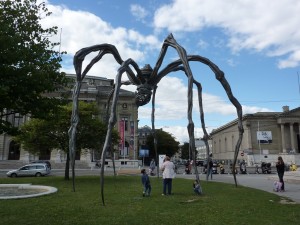 Luise Bourgois, Maman, 2010
Luise Bourgois, Maman, 2010
Another artist shown there was Jana Sterbak with her wolves. The wolves, but they may as well be coyotes, are clearly symbolic there, but very realistic. I suspect that wolf means more to Canadians than to other people, given a more visible presence of Native Americans, and elements of their culture in the everyday life. But what do they exactly mean… it’s up to you to feel…
Jana Sterbak, Titles unknown (photos taken at the exhibition Les Papesses, Palais des Papes, Avignon, 2013)
But you do not need to worry if you did not come up with an idea. A French superanthropologist Claude Levi-Strauss did it for you: Coyote has reached his/her mythical stature because they are a mediator animal between life and death.
References:
Lévi-Strauss, Claude. Structural Anthropology. Trans. Claire Jacobson. New York: Basic Books, 1963. (p. 224))


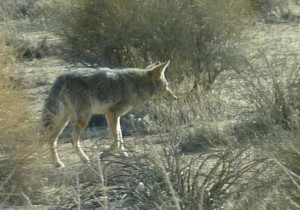

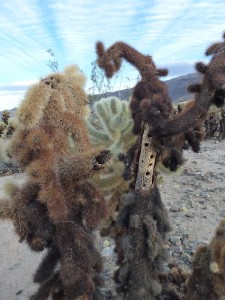
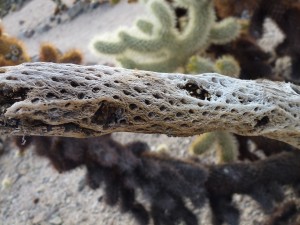

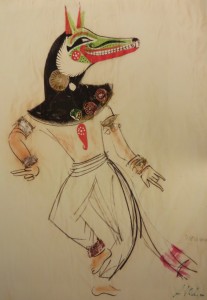
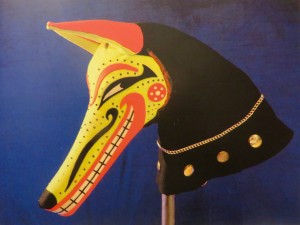



Excellent piece!